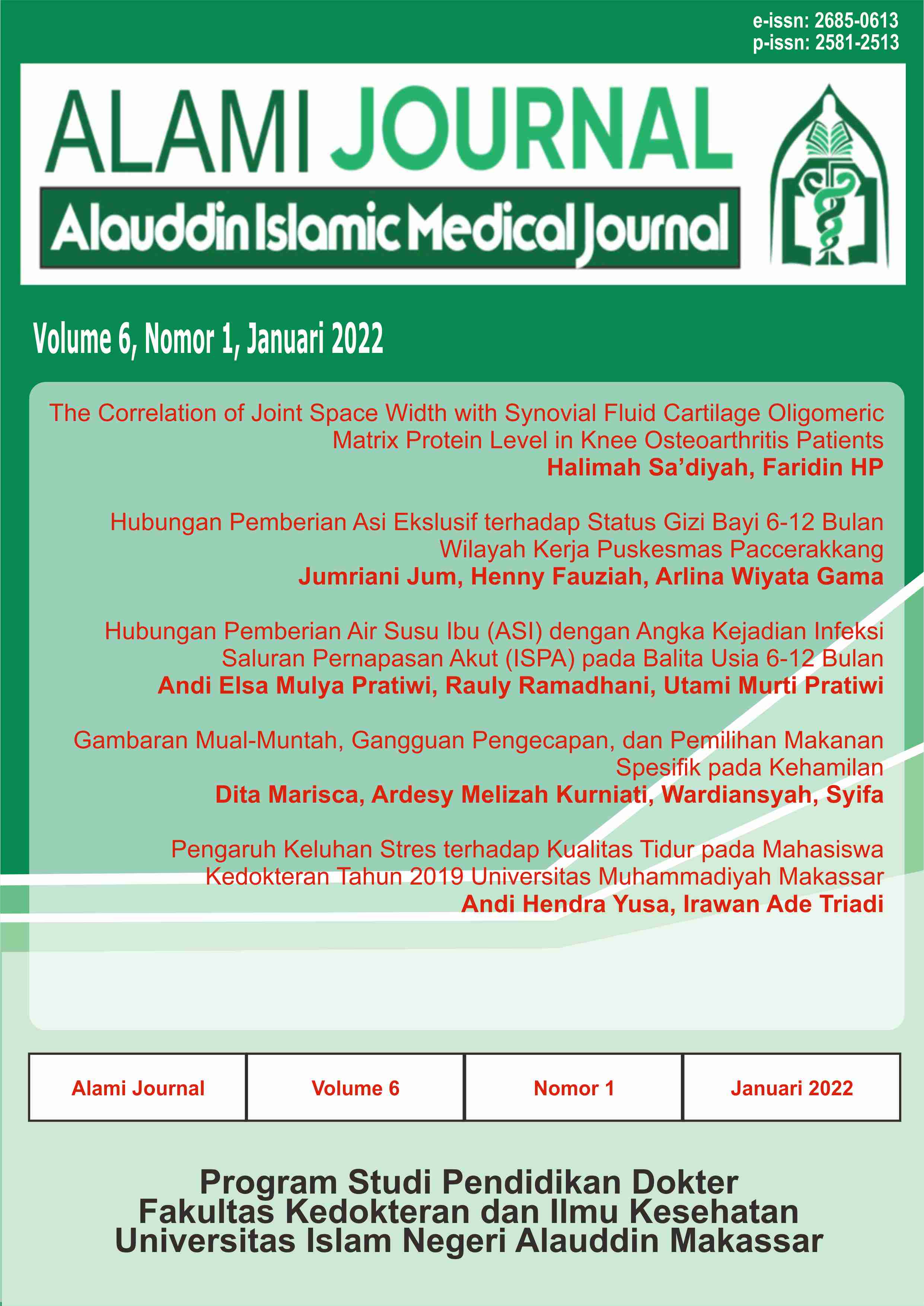THE RELATIONSHIP OF EXCLUSIVE BREASTFEEDING WITH NUTRITIONAL STATUS OF INFANTS AGED 6-12 MONTHS IN THE WORKING AREA OF PACCERAKKANG PUSKESMAS
Abstract
Breast milk is adequate food for infants in growth and development because its contents, such as nutrients and protective factors, play a role in increasing the speed of metabolism and growth to reduce infant morbidity and mortality. This study aimed to determine the relationship of exclusive breastfeeding to the nutritional status of infants aged 6-12 months in the Paccerakang Health Center Work Area. The method used is observational analytics with a retrospective approach. The sample in this study was taken using the purposive sampling method, which met the inclusion and exclusion criteria. The number of respondents was 50, while 25 respondents were taken from children who received exclusive breastfeeding and 25 who did not. Samples were taken using primary data from questionnaires and secondary data from medical records and then analyzed using the Chi-Square test with a significance level of 5% (α=0.05). The results of hypothesis testing using Chi-Square with a significance level of 5% (α=0.05), the p-value is 0.003 (P<0.05). This study's conclusion shows a relationship between a history of exclusive breastfeeding and the nutritional status of infants aged 6-12 months.
References
Bappenas (2017) Ringkasan Metadata Tujuan Pembangunan Berkelanjutan (TPB)/ Indikator Sustainable Development Goals (SDGs) Indonesia, Kementerian PPN / Bappenas.
Robinson et all (2019) ‘The World Health Organization Code and exclusive breastfeeding in China, India, and Vietnam.’, Maternal and Child Nutrition, 15(1).
UNICEF & WHO (2021) ‘World Breastfeeding Week: UNICEF and WHO call on the Government and employers to support breastfeeding mothers in Indonesia’.
Virdianty, M. M. (2020) ‘Analisis Faktor-Faktor yang Mempengaruhi Perilaku Ibu dalam Pemberian ASI Eksklusif’, Dis. Universitas Airlangga.
Dinkes (2020) Profil Kesehatan Indonesia Tahun 2019. Edited by K. RI. Jakarta.
Amir, A. Y. et al. (2019) ‘Hubungan Kadar Magnesium Dalam ASI Dan Asupan Energi Ibu Dengan Penambahan Berat Badan Bayi Usia 0-6 Bulan’, 10(1), pp. 41–48.
Destuve Rahmadanty (2020) Perbandingan Pertambahan Berat Badan dan Panjang Badan Bayi yang diberi ASI Eksklusif dan Tidak Eksklusif pada Usia 6 - 7 bulan di Kelurahan Warungboto Wilayah Kerja puskesmas Umbulharjo I Kota Yogyakarta.
Saputro, E. W. (2017) Perbedaan Pertambahan Berat Badan Bayi Usia 6 Bulan Yang Diberi Asi Eksklusif Dan Susu Formuladi Wilayah Kerja Puskesmas Mowewe Kabupaten Kolaka Timur Tahun 2017.
Michaelsen, K. . (2019) ‘Breastfeeding and Growth’, International Conference on Nutrition and Growth.
Meta Nurbaiti (2018) ‘Hubungan Pemberian ASI Terhadap Berat Badan Bayi Di Wilayah Kerja Puskesmas Sematang Borang Palembang’, Jurnal ‘Aisyiyah Medika, 1(1)
Khusna NA, N. N. (2017) ‘Hubungan usia ibu menikah dini dengan status gizi Balita di Kabupaten Temanggung’, Journal of Nutrition College, 6(1).
Labada A, Ismanto AY, K. R. (2016) ‘Hubungan Karakteristik Ibu dengan Status Gizi Balita yang Berkunjung di Puskesmas Bahu Manado’.
Putri et all (2017) ‘Kaitan Pendidikan, Pekerjaan Orang tua dengan Status Gizi Anak Pra Sekolah’, Jurnal Care, 5(2).
Lukitawati, N. (2010) Hubungan Antara Status Pekerjaan Orang Tua Dengan Status Gizi Balita Di Desa Jatisarono Nanggulan Kulon Progo Yogyakarta. Sekolah Tinggi Ilmu Kesehatan Aisyiyah.
Copyright (c) 2022 Jumriani riani Jum

This work is licensed under a Creative Commons Attribution-NonCommercial-ShareAlike 4.0 International License.
Once an article was published in the journal, the author(s) are: granted to the journal right licensed under Creative Commons License Attribution that allows others to share the work with an acknowledgement of the work's authorship. permitted to publish their work online in third parties as it can lead wider dissemination of the work. continue to be the copyright owner and allow the journal to publish the article with the CC BY-NC-SA license receiving a DOI (Digital Object Identifier) of the work.


